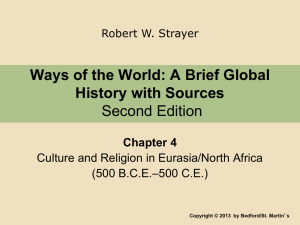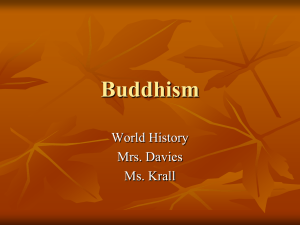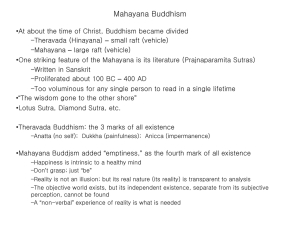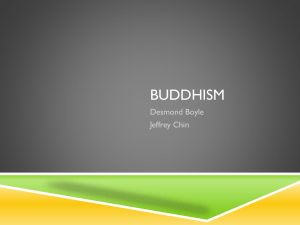Introduction to Buddhism Quiz (Office document, 1087kB)
advertisement
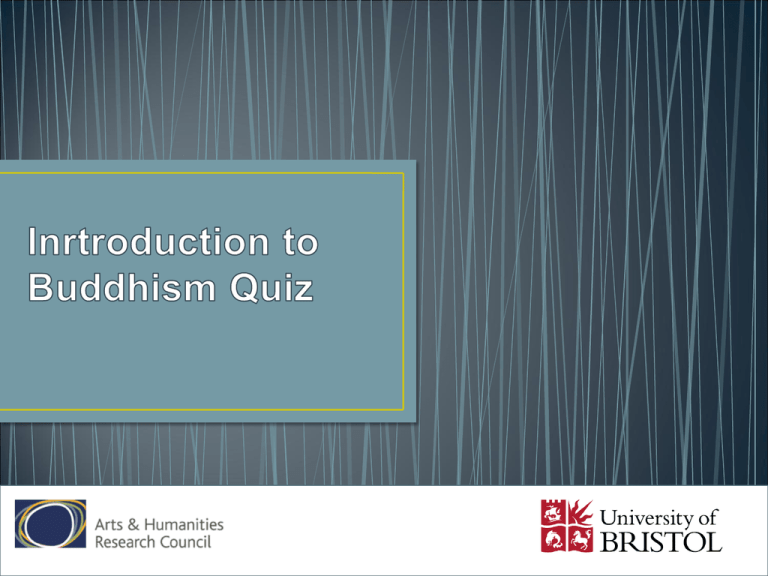
A. Incas B. Aryans C. Harappans • The religious landscape of ancient India was shaped by the ideology of the Aryans, a nomadic group who travelled into India around the beginning of the second millennium BCE. • The teachings of the social group known as brahmanas are found within texts such as the Ṛg Veda and Upaniṣads. These contain teachings, philosophies and ritual guides. • Incas are ancient Peruvians • Harappans are part of the ancient Indus Valley Civilization which pre-date the arrival of the Aryans. Next Question • The religious landscape of ancient India was shaped by the ideology of the Aryans, a nomadic group who travelled into India around the beginning of the second millennium BCE. • The teachings of the social group known as brahmanas are found within texts such as the Ṛg Veda and Upaniṣads. These contain teachings, philosophies and ritual guides. • Incas are ancient Peruvians • Harappans are part of the ancient Indus Valley Civilization which pre-date the arrival of the Aryans. Next Question A. 500- 400 BCE B. 800- 700 BCE C. 600- 500 BCE • The dates that the Buddha lived are not agreed upon, but generally placed around 400-500 BCE. • This is a estimation of when the Buddha lived. A number of sources from ancient India, Sri Lanka and the surrounding areas have been used to try and get the most accurate date. The dates are not agreed upon by all scholars. Next Question • The dates that the Buddha lived are not agreed upon, but generally placed around 400-500 BCE. • This is a estimation of when the Buddha lived. A number of sources from ancient India, Sri Lanka and the surrounding areas have been used to try and get the most accurate date. The dates are not agreed upon by all scholars. Next Question A. Suffering (duḥkha) B. Cessation (nirodha) C. Origin (samudaya) The second Noble Truth is Origin. 1. Suffering (duḥkha/dukkha): all that is unenlightened is marked by this. 2. Origin (samudaya): the origin of dukkha lies in craving (tṛṣṇā/ taṇhā). The unenlightened crave sensuals pleasures, things that they do not have and the removal of things that they do not want. 3. Cessation (nirodha): the cessation of dukkha, will come through the cessation of ignorant thought and action. In other words, the only cure for dukkha is nirvāṇa/ nibbāna. 4. Way (mārga/ magga): the path to enlightenment is outlined in in the eightfold path Next Question The second Noble Truth is Origin. 1. Suffering (duḥkha/dukkha): all that is unenlightened is marked by this. 2. Origin (samudaya): the origin of dukkha lies in craving (tṛṣṇā/ taṇhā). The unenlightened crave sensuals pleasures, things that they do not have and the removal of things that they do not want. 3. Cessation (nirodha): the cessation of dukkha, will come through the cessation of ignorant thought and action. In other words, the only cure for dukkha is nirvāṇa/ nibbāna. 4. Way (mārga/ magga): the path to enlightenment is outlined in in the eightfold path Next Question True False • Saṃsāra is not a place, instead it is the type of existence experienced by all unenlightened beings. • Saṃsāric existence is conditioned by three marks: impermanence (anitya/ anicca), not-Self (anātman/ anattā), and dis-ease (duḥkha/dukkha). • As there is no permanence there is no stability. Saṃsāric existence is in a constant state of flux and change. Next Question • Saṃsāra is not a place, instead it is the type of existence experienced by all unenlightened beings. • Saṃsāric existence is conditioned by three marks: impermanence (anitya/ anicca), not-Self (anātman/ anattā), and dis-ease (duḥkha/dukkha). • As there is no permanence there is no stability. Saṃsāric existence is in a constant state of flux and change. Next Question A. Dependent Origination B. Skilful Means C. Doctrine of the Elders • Buddhism offers a system of causation known as Dependent Origination (pratītyasamutpadā/ paṭiccasmuppāda). This system of thought maintains that everything has been caused into existence. Nothing has been created ex nihilo. • Skilful means is a translation of upāyakauśalya. • Doctrine of the Elders is a translation of Theravāda Next Question • Buddhism offers a system of causation known as Dependent Origination (pratītyasamutpadā/ paṭiccasmuppāda). This system of thought maintains that everything has been caused into existence. Nothing has been created ex nihilo. • Skilful means is a translation of upāyakauśalya. • Doctrine of the Elders is a translation of Theravāda Next Question True False • The Buddha had attained enlightenment during his lifetime, he did not die nor did he vanish. Despite being enlightened he still had to receive the results of previous karmic actions. It should be remembered that one enlightened the Buddha was not producing any karma. • Nirvāṇa/nibbana, as with saṃsāra, is not a place. Instead it is a form of existence which is free from the conditions of saṃsāra. Next Question • The Buddha had attained enlightenment during his lifetime, he did not die nor did he vanish. Despite being enlightened he still had to receive the results of previous karmic actions. It should be remembered that one enlightened the Buddha was not producing any karma. • Nirvāṇa/nibbana, as with saṃsāra, is not a place. Instead it is a form of existence which is free from the conditions of saṃsāra. Next Question A. Vinaya B. Nikayas C. Abhidharma • The Buddha ordained monks (bhikkhus) and nuns (bhikkhunis) during his lifetime and there were was the creation of the Vinaya, a text outlining the rules of the monastic community. • The Nikayas are the collection of suttas found in the Pali Canon. • The Abhidharma is also found within the Pali Canon and is a collection of descriptions of Buddhist doctrines. Next Question • The Buddha ordained monks (bhikkhus) and nuns (bhikkhunis) during his lifetime and there were was the creation of the Vinaya, a text outlining the rules of the monastic community. • The Nikayas are the collection of suttas found in the Pali Canon. • The Abhidharma is also found within the Pali Canon and is a collection of descriptions of Buddhist doctrines. Next Question True False • In Buddhist thought karma has a causative nature. The actions that are intentionally performed by the individual will have a particular karmic result. Well-intentioned good deeds will result in a pleasant and favourable karmic result whilst malicious and hurtful misdeeds will result in a poor and unfavourable karmic result. • Karma does not always have immediate results, but can take many lifetimes to have an effect. Next Question • In Buddhist thought karma has a causative nature. The actions that are intentionally performed by the individual will have a particular karmic result. Well-intentioned good deeds will result in a pleasant and favourable karmic result whilst malicious and hurtful misdeeds will result in a poor and unfavourable karmic result. • Karma does not always have immediate results, but can take many lifetimes to have an effect. Next Question A. A child, an old person, a mad person and a brahmin B. A couple, an ill person, an old person and a corpse C. An old person, an ill person, a corpse and an ascetic • Siddhārtha (the Bodhisattva) rides with his charioteer and sees an old man, a sick man, a corpse and an ascetic. Upon seeing this he decides to leave his home and become an ascetic. • When he was young it was predicted that Siddhārtha could have one of two destinies: he could become a great ‘wheel turning’ king (cakravartin/cakkavattin) or a buddha. He was hidden from all unpleasant things by his father who wanted him to become a king. Next Question • Siddhārtha (the Bodhisattva) rides with his charioteer and sees an old man, a sick man, a corpse and an ascetic. Upon seeing this he decides to leave his home and become an ascetic. • When he was young it was predicted that Siddhārtha could have one of two destinies: he could become a great ‘wheel turning’ king (cakravartin/cakkavattin) or a buddha. He was hidden from all unpleasant things by his father who wanted him to become a king. Next Question True False • The different approaches towards the Buddha’s teaching can be split into two different parties: Mainstream Buddhism and Mahāyāna Buddhism. • Mainstream Buddhist schools include: Sarvāstivāda, Sautrāntika, Theravāda, Pudgalavāda, and Mahāsāṃghika. • In modern Buddhism the only surviving mainstream school is Theravāda Buddhism. • Mahāyāna schools include: Zen/Chan, Pure Land, Shingon, Tendai, Nichiren, and Tibetan Buddhism. • The different approaches towards the Buddha’s teaching can be split into two different parties: Mainstream Buddhism and Mahāyāna Buddhism. • Mainstream Buddhist schools include: Sarvāstivāda, Sautrāntika, Theravāda, Pudgalavāda, and Mahāsāṃghika. • In modern Buddhism the only surviving mainstream school is Theravāda Buddhism. • Mahāyāna schools include: Zen/Chan, Pure Land, Shingon, Tendai, Nichiren, and Tibetan Buddhism.

